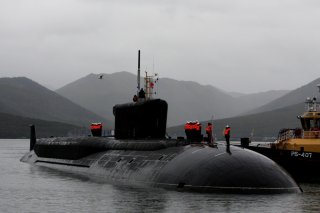The Top 5 Best Submarines in Russia Ever Sent to Sea
The Russian Federation has recently sought to pick up where its Soviet predecessor left off, launching two ambitious new submarine projects as naval tensions sharpen between the Kremlin and NATO.
One of the global leaders in submarine production, the Soviet Union is responsible for many of the best and most innovative submarine classes in maritime history. The Russian Federation has recently sought to pick up where its Soviet predecessor left off, launching two ambitious new submarine projects as naval tensions sharpen between the Kremlin and NATO.
Here are the five top Russian and Soviet submarines.
Akula (Typhoon)
Of Red October fame, the Akula-class SSBN (nuclear powered ballistic missile submarines)—better known by its NATO reporting name “Typhoon”— is among the most iconic Soviet vessels ever conceived. Introduced in 1981, the lead Typhoon-class boat Dmitry Donskoi remains the largest military submarine in the world. Armed with up to twenty R-39 Rif Submarine-Launched Ballistic Missiles (SLBMs), as well as 533mm and 650mm torpedo tubes for self-defense in a pinch, the Typhoon submarines boasted a staggering amount of firepower to rival the competing U.S. Ohio-class SSBNs.
Improved Kilo-Class (Project 636.3)
Widely regarded as Russia’s best non-nuclear submarine, the Improved Kilo-class (Project 636.3) is the latest major development of the Soviet navy’s original Project 877 Kilo-class submarines. These diesel-electric attack boats are primarily intended for anti-submarine warfare (ASW) and anti-ship operations in littoral waters. The project 636.3 boats boast a healthy complement of six torpedo tubes, but these submarines’ real strength lies in their extremely low noise signature output—the Improved Kilos are so quiet that the U.S. Navy colloquially refers to them as “black holes.”
Delta IV
The Delta IV-class is the culmination of a decades-long Soviet effort to perfect its flagship SSBN line. These Soviet-era vessels—all seven of which are still currently serving in the Russian Navy’s Northern Fleet—offer reduced noise levels over the Delta I-III classes, hull design tweaks, an expanded selection of compatible torpedoes and anti-ship missiles, and more powerful SLBMs along with weapons targeting upgrades. The Delta submarines became a pillar of the USSR’s “bastion” naval strategy, aimed at carving out heavily-defended spaces within which Soviet SSBNs could operate safely and effectively.
Yasen-M
Russia’s new flagship line of nuclear-powered cruise missile submarines, the Yasen-M-class boasts a significantly lower acoustic signature than its Soviet-era predecessors. The Yasen boats will be compatible with Russia’s upcoming 3M22 Tsirkon winged, hypersonic anti-ship cruise missile, posing a credible threat against NATO’s carrier strike groups. The first Yasen-M submarine—K-561 Kazan—was commissioned in May 2021, with seven more planned through 2028.
Borei
The Project 955 Borei-class SSBNs are the newest sea leg of Russia’s nuclear triad. Equipped with “invulnerable” RSM-56 Bulava submarine-launched ballistic missiles (SLBM), the Borei submarines are capable of delivering a payload orders of magnitude more destructive than the R-39 Rif SLBMs of the Typhoon0-class. Ten Borei submarines are planned as part of Russia’s 2027 armament cycle, with four already in active service.
Mark Episkopos is a national security reporter for the National Interest.
Image: Wikimedia Commons

